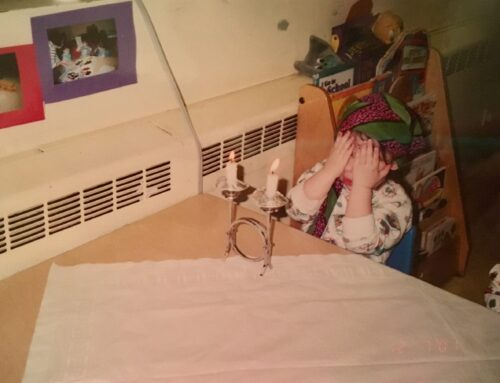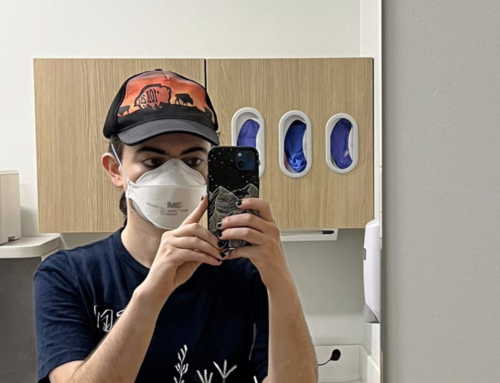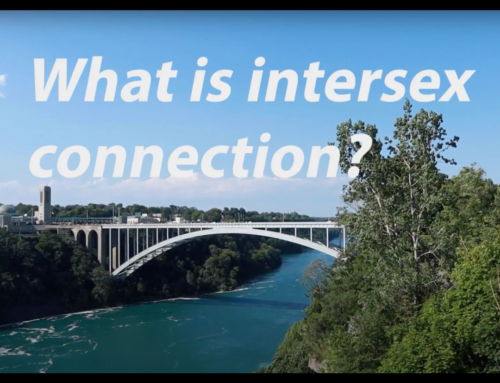By: Amanda Saenz, interACT Youth member and “Raven” on MTV’s Faking it
TW: q-slur
Faking It officially came to an end this week, and I think it’s time to discuss the importance of all the show has done for the intersex community. In early November, as the anticipated cold of winter was beginning to settle over Seattle, MTV flew me down to vibrant Los Angeles to film an episode of their acclaimed show Faking It. This was all a part of a larger goal taken on by both the show’s writing team and interACT to ensure that the intersex community would be accurately represented within the show.
interACT, an intersex advocacy organization that I have been involved with for a few years now, has been working with the writers of Faking It ever since the they had the idea to make Lauren’s character intersex. This work included reading over scripts, discussing the experiences (both social and medical) of intersex folk, and offering input on the direction of the show.
It was, surprisingly, Faking It that had reached out first.
 Already the writing team had exhibited a lot of initiative with their approach to Lauren’s characterization. Simply put, they cared enough to bring intersex people into the writer’s room. Because of this, many of the real experiences of various interACT members had been woven into Lauren’s character as the show progressed.
Already the writing team had exhibited a lot of initiative with their approach to Lauren’s characterization. Simply put, they cared enough to bring intersex people into the writer’s room. Because of this, many of the real experiences of various interACT members had been woven into Lauren’s character as the show progressed.
And so I came to LA with a profound sense of hope for the direction that Faking It was taking. I was a confusing mix of nerves, eager and excited to be on set and eventually in front of the camera. The gravity of this situation was not lost on me; how could it be? I was going to be the first (publicly out) intersex person portraying an intersex character on television. This specific detail was something that I tried not to think too hard about in the moment. Otherwise, I might have seized up under the weight of such a historic occasion.
This history was made largely due to the work of two people who paved the way for me to be there. My friend and interACT Youth Coordinator, Emily Quinn, along with Executive Director of interACT, Kimberly Zieselman were together the essential bridge between interAct and Faking It.

from left to right: interACT Youth members Arti and Ryan; Faking It’s Carter Covington; interACT Executive Director Kimberly Zieselman and Youth Coordinator Emily Quinn
Really, interACT and Faking It had developed a partnership akin to a close friendship. It is this crucial relationship that provides a model for writers, studios, and show runners to create characters whose storylines are honest reflections of the experiences of marginalized identities.
This need for an increase in the inclusion of organizations is important because organizations are created and supported by the collective voices of their members, thus mitigating the risk of having a single voice speak on behalf of an entire community. Additionally, these organizations might empower the trans or queer actor, many of which have had to fight uphill battles alone.
interACT Youth proves a good example of this, especially as an organization which built itself from the ground up. We work to ensure that the voices of all our members have the space to be heard, and it is in this way that we have created a community-oriented organization. The intrinsic value we place on the voices of all our members wonderfully diversifies our movement, which ultimately contributed to the dimensionality of Lauren’s character.
 Studios ought to take the initiative to include us if we as a society are ever to overcome the dissonance between the realities of our lived experiences and how they’re portrayed onscreen. The resources are out there, ready and excited to jump in and create positive representation. It’s all a matter of taking that next step.
Studios ought to take the initiative to include us if we as a society are ever to overcome the dissonance between the realities of our lived experiences and how they’re portrayed onscreen. The resources are out there, ready and excited to jump in and create positive representation. It’s all a matter of taking that next step.
Simultaneously, we must continue to fight to make our voices heard. This is not a call towards passivity: we certainly cannot sit and wait patiently for writers and producers to come knocking at our doors. That, frankly, would be unrealistic. However, there already exist well-established organizations that have the kind of pull that could push studios to include more marginalized identities.
GLAAD, for example, is a leader in the movement towards accurate representation and has collaborated with many networks to ensure that their shows do right by queer folk, though one might begin to wonder why we don’t see more channels reach out to GLAAD.
The goal should be authenticity, and indeed we see more and more of that with shows like Transparent and Orange is the New Black. Ultimately, I think that the intent of this form of representation is to avoid already well-established tropes that have been, frankly, toxic towards our communities.
Queer communities have been been combating this by creating our own art for decades. Certainly these are invaluable sources for us, but at the same time mainstream media is what many people, both straight and queer, have immediate access to. Simply because these pockets exist doesn’t mean that pop outlets should eschew our inclusion; after all, it is immensely empowering and gratifying to see narratives that one might identify with on screen.

from left to right: Amanda Saenz, “Raven;” Rita Volk, “Amy;” Carter Covington, Show Runner; Bailey de Young, “Lauren;” Emily Quinn, Youth Coordinator
Though it saddens me that Faking It has come to an end, I’m hopeful too. If they can manage to foster a constructive relationship with an organization like ours, then surely other shows should be able to follow in their footsteps. InterACT Media is working on new projects to raise intersex visibility and I am excited to see where it leads!






